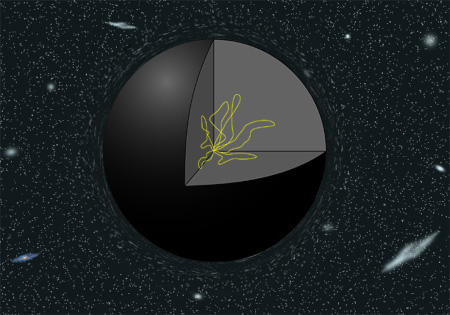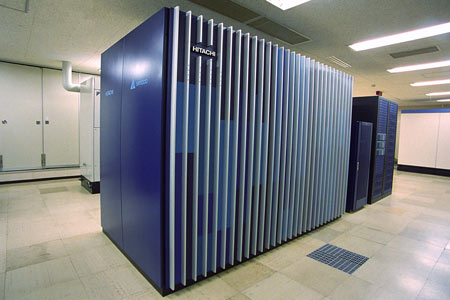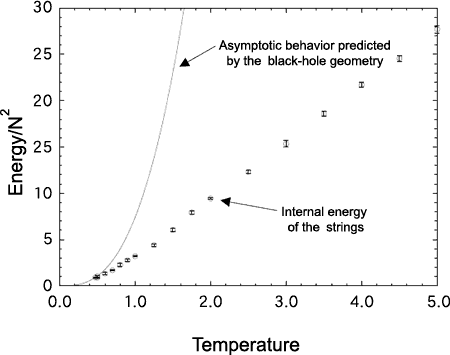Abstract:
A research group led by Jun Nishimura, Ph. D. , an associate professor at KEK, succeeded for the first time in revealing the state inside a black hole by computer simulations using superstring theory.
|
The research group performed numerical simulations using superstring theory, which describes the behavior of elementary particles, and confirmed for the first time that the temperature dependence of the energy inside a black hole agrees with the power law behavior expected from calculations based on Hawking's theory.
This result demonstrates that the thermodynamical properties of the black hole such as the Hawking radiation can be explained by the collection of strings that appears in superstring theory.
Black holes are astronomical objects predicted by Einstein's general relativity. Due to their strong gravitational effects, the space and time are distorted so much that any matters or even light are confined inside. In 1974 the British physicist, Stephen Hawking, showed theoretically that the black holes actually emit light and particles from its surface, which consequently makes the black hole shrink little by little. Since then, it has been suspected that black holes should have certain interior structure.
However, it has not been possible to describe the state inside a black hole since the curvature of the space time becomes so large towards the center, that general relativity becomes no longer applicable there due to quantum effects.
In elementary particle theory, on the other hand, superstring theory has been proposed to unify general relativity and quantum mechanics in a consistent manner. Superstring theory describes all the elementary particles that have been observed to date as various oscillating modes of strings with tiny length, which propagate in a higher dimensional space-time such as 10-dimensional or 11-dimensional ones. Gravitons, which mediate gravity, appears in that way, and general relativity is naturally extended to the scale of elementary particles. Whether this theory can describe the interior structure of black holes has been attracting attention of theoretical physicists all over the world.
The research group established a method which treats the oscillation of strings efficiently depending on its frequency. The thermodynamical behavior of the collection of strings, which is considered to exist inside a black hole (Fig.1), was calculated by the method using the supercomputer "Hitachi SR11000 model K1" (Fig.2, theoretical performance : 2.15 TFLOPS) installed at KEK in March 2006. Figure 3 shows the numerical data representing the temperature dependence of the energy that the collection of strings has. As the temperature is lowered, the behavior of the black hole predicted by Hawking's theory (represented by the solid line) was reproduced for the first time.
It has long been considered that the state inside a black hole can only be deduced from the Hawking radiation from its surface. The result of this research has demonstrated that the mysterious thermodynamical properties of black holes can be explained by the collection of strings fluctuating inside.
It is expected that superstring theory will develop further and play an important role in solving interesting problems such as the evaporation of black holes, the state of the early universe and the creation of everything.
This work has been published in Physical Review Letters.
| [ Media Contact ] |
Jun Nishimura, KEK Theory Group
+81 29-864-5398
Youhei Morita, KEK Public Relations Office
+81 29-879-6047
|
 |
| Figure 1 : Artist's rendering of the interior of a black hole as a collection of strings. |
 |
| Figure 2 : Supercomputer "Hitachi SR11000 model K1" provides 2.15 Tera Flops peak performance. The machine is under operation since March 2006. |
 |
| Figure 3 : The energy of the collection of strings is plotted against the temperature. Solid line represents the behavior of the black hole predicted by Hawking's theory. The results agree in the lower temperature regime, where the calculation based on general relativity becomes valid. |
|



